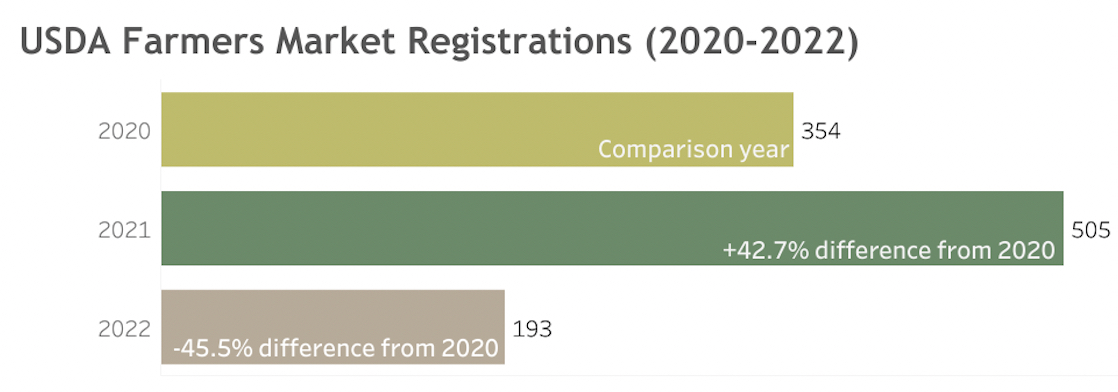When was the last time you attended a farmers market? Maybe you walked past bustling tables downtown, attended a county fair, or spent the day at a farm. Fruits and vegetables lined the tables in bright bursts of color, while the scent of handmade soaps and baked goods drifted through the air. A guitar strummed as people greeted each other, exchanging warm hugs on a breezy spring day.
Farmers markets are more than places of commerce for small businesses, these events offer valuable social opportunities for attendees [2]. It is estimated that farmers market customers have 15 to 20 interactions per visit compared to the one to two interactions if they had visited a grocery store instead [1].
The 2020 coronavirus pandemic disrupted farmers markets’ abilities to operate as in-person events. Many farmers markets shifted their focus to e-commerce platforms, providing goods to customers via curbside pickups [2]. This continued financial support from e-commerce kept local businesses afloat, however farmers markets, which traditionally relied on word of mouth advertising, lacked the means to reach out to a larger customer audience.
To improve the advertising capabilities of farmers markets, the USDA Local Food Directories, a collaborative project between Michigan State University and United States Department of Agriculture’s (USDA) Agricultural Marketing Service, were developed. The directories’ purpose is to increase the visibility of agricultural events through consolidated online listings [4].
Farmers markets have now reopened as in-person events, but long term impacts of the 2020 pandemic shutdowns are still unknown [3].
Curious human that I am, I decided to investigate the number of farmers markets that were registered with the USDA Local Food Directories from 2020 to 2022 [4].
Turns out that when we compare the yearly registrations to the amount in 2020, there was a 42.7% increase in registrations in 2021, followed by a decrease of -45.5% in 2022.

Figure 1. Bar graph comparing 2021 and 2022 to the 2020 registrations.
The increase in registrations in 2021 shows the societal push for reopening the economy, though the decline in registrations in 2022 is more puzzling. Were farmers markets returning to older methods of advertising? Had the the maximum number of farmers markets submitted registrations? We still need additional survey data to dissect the exact cause of these yearly registration trends.
What we can tell from the data is which US states had the most and least USDA farmers market registrations per year.

Figure 2. Maps comparing the number of USDA farmers market registrations per state by year (2020-2022). Dark green signifies the most registrations.
California (2020 & 2022) and Pennsylvania (2021) have the most registrations! Keep up the good work!
We can also see the gaps that exist within the USDA Local Food Directories by identifying states with the least farmers market registrations. With 1,054 farmers markets within the dataset, it is unlikely that all US farmers markets have registered with the free online marketing service.
The USDA and its stakeholders can leverage this data-derived insight by encouraging states with fewer registered farmers markets to submit their information to the directory.
The pandemic made transitioning to online advertising a necessity. Only time will tell if farmers markets will continue to move marketing functions online or will return to the good ole’ word of mouth method.
To find out how I cleaned the data, check out my Github project repository for the R-scripts, Google Sheets Changelog, and .csv files. Also check out the interactive Tableau dashboard to learn more about USDA farmers market registrations in the US!
Appendix
Table 1. U.S. States with the most and least USDA farmers market registrations by year (2020-2022)
| Year | Most Registrations | Least Registrations |
|---|---|---|
| 2020 | California |
|
| 2021 | Pennsylvania |
|
| 2022 | California |
|
Citations
[1] Farmers Market Coalition. (2011). The Cultural Significance of Farmers Markets. URL: https://farmersmarketcoalition.org/the-cultural-significance-of-farmers-markets
[2] Farmers Market Coalition. (2023). Farmers Markets Support Healthy Communities. URL: https://farmersmarketcoalition.org/education/support-healthy-communities.
[3] Posada, P. (2022). A (Market) Place for Everyone. Project for Public Places. URL: https://www.pps.org/article/a-market-place-for-everyone
[4] USDA. (2023). Data Sharing. URL:https://www.usdalocalfoodportal.com/fe/datasharing/
